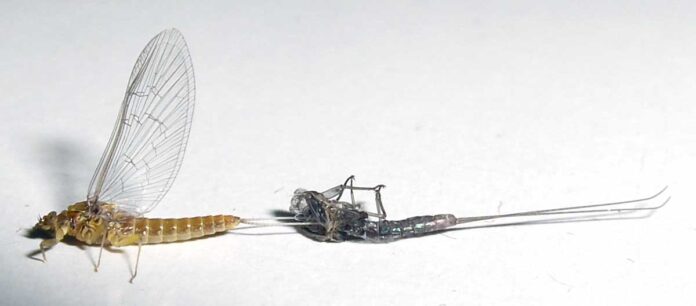A blue-winged olive emerges from its nymphal shuck.
Photo by Stemonitis, via Wikipedia
Everybody loves the blue-winged olive hatches of spring, when the mayflies emerge on cloudy or even snowy days. It’s often the first great dry-fly fishing of the year, and the bugs are good-size, 14s or 16s. But autumn can also be a great time to fish Baetis hatches, offering anglers a chance to cast surface patterns into November. If you spend most of your time chucking big streamers in the fall, you’ll enjoy a chance to lighten things up and give your shoulder a rest.
There is one caveat: late-season BWOs can be downright tiny, down to a size 24, which means that you’ll need to adjust your equipment and tactics. A 9-foot, 3- or 4-weight rod is usually the best tool for the job. A long rod helps with mending and holding line off the water, to aid in achieving the dead-drift presentation necessary for fooling trout that may have seen many flies over the preceding months. A floating line with a long front taper allows more delicate presentations, but keep in mind that you’ll be trying not to put the line over the trout, anyway.
To get that fly-and-leader-only presentation, you’ll a little extra length. I use a 10- to 15-foot leader, with a 5X tippet, if I can get away with it. Oftentimes, 6X is required by the tiny flies or the finicky, wary trout. I like to approach a rising fish from downstream and make a quartering-upstream cast, so the fish sees the fly and tippet only.
Here are my Top 5 choices for fishing this late-season emergence:

1. Sparkle Dun, sizes 18-22.

2. Cripple Dun BWO, sizes 18-20.

3. Blue-Winged Olive Parachute, sizes 18-20.

4. RS2, sizes 18-24.

5. Smith’s Crippled Emerger, sizes 18-20.
Because these BWO flies are so tiny, I often fish one as a dropper off a larger fly that I can actually see. A size 18 or 20 Indicator Parachute makes a nice indicator for that size 22 emerger.
Credit: Source link






























